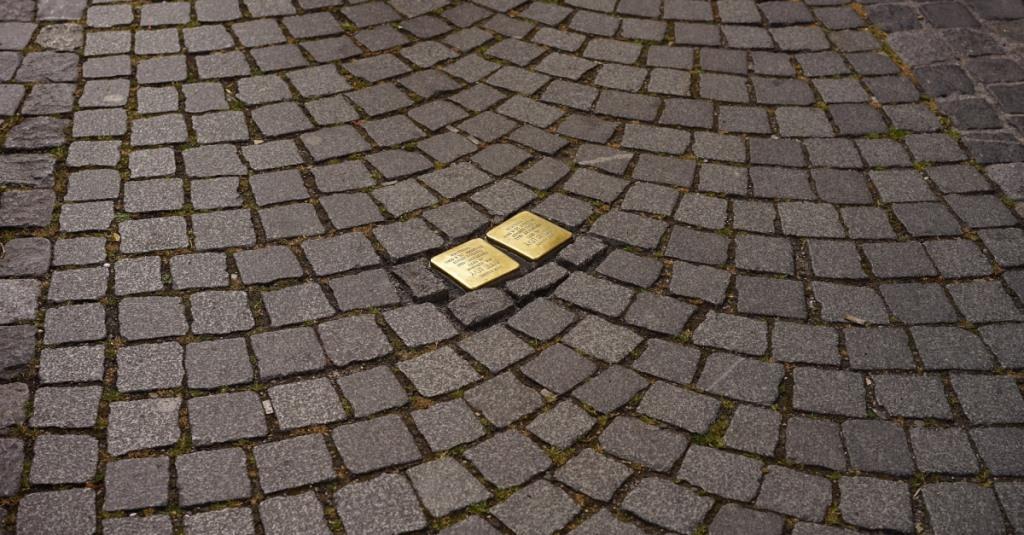During his court-martial, Josef told the court that he had direct Jewish ancestors. This was quite a revelation, as he had earlier told military interrogators that he was not Jewish. His court martial testimony, that his own grandfather was Jewish, seems like a desperate bid to gain the sympathy of the court. My own genealogical research has definitively shown that Josef’s ancestry, on both sides, is Catholic well back into the 1500s.
At various points during his interrogations and court martial testimony, Josef also mentioned that his “father-in-law” was Jewish. In actual fact, it was Josef’s step-father-in-law who was Jewish, a man named Abraham Wolfgang Elkan. When I published my book on Josef Jakobs (The Spy in the Tower), I told a bit of the tale of Elkan and, while I knew he had died before 1943, the year that his wife (Therese (née Knöffler) Elkan) passed away, I did not know the circumstances of his passing. Had he perished in a concentration camp?
What Josef did not mention during his interrogations, nor at his trial, was that his aunt-in-law, Johanna Knöffler, was living with a Jewish gentleman as well. While not married, the couple apparently lived as what we would now call common-law. While the name of this gentleman did not survive in our family lore, we do know that he was eventually taken to a concentration camp where he was murdered during the Shoah.
Sooo… two Jewish in-laws, the husbands/boyfriends of two sisters: Therese (née Knöffler) Elkan and Johanna Catharina Knöffler. With my discovery of the 1939 German Minority Census, I decided to try and uncover the stories of these two men. These are their stories. I covered Wolfgang Elkan’s story in the previous blog post and today we are looking at Gustav Goldemann.
Gustav Goldemann
Our family knew the tragic fate of Johanna Knöffler’s “boyfriend”. We had his photograph. We knew about his pet rabbit. We just never knew his name. But, all that changed a few weeks ago, thanks to the 1939 German Minority Census, a census that documented all of the households which contained individuals of Jewish ancestry. Even non-Jews were included in the census if they lived with a Jew.
I searched for my great great aunt, Johanna Knöffler (a non-Jew) and… found her, living at Neue Roßstraße 17 in Berlin-Mitte. There was one other person listed for that address, Gustav Goldemann. I had found him. Not only did we have a photograph, now we had his name.
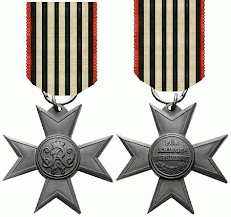
(from Wikipedia)
My great great aunt, Johanna Knöffler was the youngest child of hairdresser Albert Erwin Ludwig Knöffler and his wife Alma Adelheid Therese Jacob. Born on 9 December 1886 in Berlin, Johanna seems to have lived under the radar for much of her life. The Jakobs family papers included one document, a 1920 certificate, which awarded her the Verdienstkreuz für Kriegshilfe (Merit Cross for War Aid). Her address on the certificate was given as Neue Roßstraße 17, the same address she would have 19 years later in the 1939 German Minority Census. Exactly what patriotic civilian war aid service she performed during the First World War is unknown. Later in life she worked at a bank or in shop. How she came to meet Gustav Goldemann is unknown. Perhaps she worked in a shop that he frequented.

From Jakobs family archives
(Copyright 2020 – G.K. Jakobs)
As for Gustav, he was born 28 March 1874 in Bromberg, Posen (now Bydgoszcz, Poland). By 1906, Gustav and his family had moved to Berlin and were living at the Lange Straße 2 in Berlin-Mitte.
That year, on 7 August, Gustav married Phillippine Rothmann. The marriage was not a long nor, apparently, a happy one. In 1907, the couple had a child, Alice Agnes Goldemann, and Gustav was living at Neue Roß Straße 17, presumably with his wife and child. The following year, on 27 April, 1908, Gustav and Phillippine parted ways and divorced.
With a small child to care for, Phillippine made the only sensible decision and re-married, to one Louis Weißenberg, on 23 February 1909. Unfortunately this marriage, too, would end in divorce when the couple parted ways on 14 July 1921. As for Gustav, he continued to live at Neue Roß Straße 17 where, at some point, he was joined by Johanna Knöffler.
The Berlin address directories trace Gustav through the 1910s and 1920s, always at the Neue Roß Straße address. His occupation was “Herrenmode”, men’s fashion. Perhaps he worked in a shop, or was a fashion designer or a tailor. Hard to say.
As for why Gustav and Johanna never married… that is a complete unknown. Johanna’s sister had married a Jew in 1919. Was it because Gustav was divorced? Johanna and her sister were raised in the Lutheran faith so perhaps that was part of it.
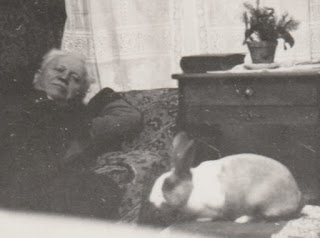
From Jakobs family archives
(Copyright 2020 – G.K. Jakobs)
As the 1930s progressed, and Nazi laws continually stripped rights and privileges from the Jews, Gustav Goldemann apparently went out less and less. Far better to remain out of view of the Nazis. According to our family story, Gustav and Johanna had a pet rabbit that they kept at home (photo at left). One of the Nuremberg laws prohibited Jews from owning pets.
Given that Gustav and Johanna were not legally married, her non-Jewish status did not confer any protection to him. Had they been married, it is possible that she could have kept him safe for longer. Or perhaps not. Had they been married, it would have been a non-privileged mixed marriage and the non-Jew in such couples were under enormous pressure to divorce their Jewish spouse.
In the end, Gustav was deported from the Grunewald railway station to Riga Ghetto, Latvia on 19 January 1942 aboard Transport IX. He was 68 years old and would never return. The YadVashem site has some video testimonials from Osttransport #9 as well as several write-ups. From these, we can glean what became of Gustav.
In the days leading up to 19 January 1942, Gustav was likely picked up by two Gestapo officers and taken to the synagogue on Levetzowstrasse for processing. He was allowed to bring a suitcase with some essentials and told that he would be “resettled”. While waiting in the synagogue, sometimes for days, several individuals passed away (stroke, heart attack). On the evening of 19 January, after almost 1000 Jews had been gathered into the synagogue, the able-bodied Jews were marched seven kilometres to Grunewald train station. The infirm and those unable to walk were transported to the train station in trucks. I found a police list of deportees on Osttransport #9 on 19 January 1942 to Riga. Gustav is #622 on the list and, under Notes is the following comment “nicht laufend”.

(From Arolsen-Archives)
Gustav was infirm and could not walk. This explains the two photographs above in which he is either seated or lying down. I have a very vague recollection of my Dad saying something along the same lines, that Gustav was not well and couldn’t move, but he is no longer here to consult.
As an infirm senior, Gustav was likely transported to Grunewald aboard a truck. Once at the train station, Gustav and over 900 other Jews were loaded aboard freight cars with about forty to fifty people per car. The train departed from Berlin and arrived in Skirotava on the outskirts of Riga on 23 January 1942. Witness reports state that some individuals died on the train.
Arriving at Skirotava in a deep frost, the elderly and infirm were separated out from the other individuals and loaded aboard trucks. The able-bodied were marched several kilometres during the depth of winter to the Riga Ghetto. The individuals aboard the trucks were not so fortunate. “Some of the deportees were selected and suffocated in gas vans or brought to the forest of Rumbula and shot.” I am going to guess that Gustav, unable to walk, was one of these unfortunate individuals. This is, of course, presuming that he didn’t pass away earlier in the synagogue or on the transport train.
As for Johanna, she continued to live in Berlin, although, given that Neue Roß Straße 17 ended up in East Berlin, the Soviet controlled sector, after the war, she must have moved to West Berlin at some point. I do know that in the late 1960s, she was living at Meraner Straße 45, just a few buildings away from her niece, Margarete, who lived at Meraner Straße 33 in Berlin-Schöneberg.
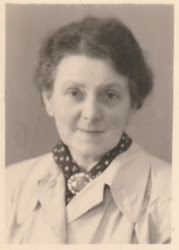
From Jakobs family archives
(Copyright 2020 – G.K. Jakobs)
My mother met Johanna, a.k.a. Tante Hanni, in 1961 on a visit to Berlin. According to her, Tante Hanni was a sweetheart, kind and caring. She was quite spry, even at 75 years old, and her mind was still sharp. In later years, however, her mind began to fail and her niece, Margarete (my grandmother), cared for her.
Eventually, the care-giving became too much and Margarete placed Tante Hanni into a care home, likely at Domincus Straße 5-9 in Berlin-Schöneberg, her last residence.
After a short illness, Tante Hanni passed away on 3 January 1971 at the Krankenhaus Hubertus in Berlin-Nikolasee. A memorial was held on 12 January 1971 at the Krematorium Wilmersdorf. Less than six months later, Margarete herself passed away at the age of 69.
As for Gustav’s ex-wife and child… Alice Agnes Goldemann escaped to the United States on 30 July 1938 arriving in New York aboard the SS President Harding. Two years later, on 28 December, 1940, Alice married Emil Spitz, a native of Austria. The couple lived in Chicago and Alice passed away there in 1995. I couldn’t find any children of Alice and Emil, although it is always possible that they exist.
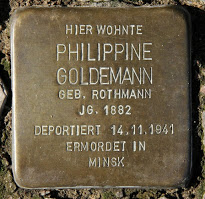
Alice’s mother, Phillippine would not be so fortunate. Phillippine, who changed her surname back to Goldemann in 1925, after her divorce from Louis Weißenberg, was deported from Berlin on 14 November 1941 to Minsk, Russia. She was 59 years old and likely murdered there by the Nazis shortly after her arrival.
A Stolperstein was placed outside her last residence at Eosanderstraße 23 in Berlin-Charlottenburg, just east of Schloß Charlottenburg.
I have not come across a Stolperstein for Gustav Goldemann and I begin to think that it it is time to lay a stone for this relation of the family of Josef Jakobs. I have submitted an inquiry to the International Tracing Service as well, just to see if they have any further information.
N.B. 30 October 2020 – I had submitted two photos of Gustav Goldemann to the Yad Vashem site and they are now live.
Sources
Jakobs family papers
Ancestry – genealogy documents
Arolsen-Archives site
Stolpersteine of Berlin site
YadVashem site – Transport IX from Grunewald 19 January 1942
